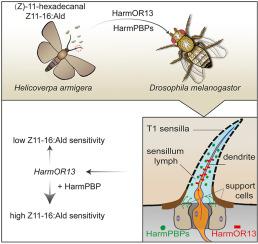Insect Biochemistry and Molecular Biology ( IF 3.8 ) Pub Date : 2021-02-15 , DOI: 10.1016/j.ibmb.2021.103554 Hao Guo 1 , Ping-Ping Guo 1 , Ya-Lan Sun 2 , Ling-Qiao Huang 3 , Chen-Zhu Wang 1

|
Helicoverpa armigera utilizes (Z)-11-hexadecenal (Z11-16:Ald) as its major sex pheromone component. Three pheromone binding proteins (PBPs) and two general odorant binding proteins (GOBPs) are abundantly expressed in the male antennae of H. armigera. However, their precise roles in the olfactory detection of Z11-16:Ald remain enigmatic. To answer this question, we first synthesized the antibody against HarmOR13, an olfactory receptor (OR) primarily responding to Z11-16:Ald and mapped the local associations between PBPs/GOBPs and HarmOR13. Immunostaining showed that HarmPBPs and HarmGOBPs were localized in the supporting cells of trichoid sensilla and basiconic sensilla respectively. In particular, HarmPBP1 and HarmPBP2 were colocalized in the cells surrounding the olfactory receptor neurons (ORNs) expressing HarmOR13. Next, using two noninterfering binary expression tools, we heterologously expressed HarmPBP1, HarmPBP2 and HarmOR13 in Drosophila T1 sensilla to validate the functional interplay between PBPs and HarmOR13. We found that the addition of HarmPBP1 or HarmPBP2, not HarmPBP3, significantly increased HarmOR13's response to Z11-16:Ald. However, the presence of either HarmPBP1 or HarmPBP2 was ineffective to change the tuning breadth of HarmOR13 and modulate the response kinetics of this receptor. Taken together, this work demonstrates both HarmPBP1 and HarmPBP2 are involved in Z11-16:Ald detection. Our results support the idea that PBPs can contribute to the peripheral olfactory sensitivity but do little in modulating the selectivity and the response kinetics of corresponding ORs.
中文翻译:

气味结合蛋白对棉铃虫中 (Z)-11-十六烯醛的嗅觉检测的贡献
棉铃虫利用 ( Z )-11-十六烯醛 (Z11-16:Ald) 作为其主要的性信息素成分。三种信息素结合蛋白 (PBPs) 和两种一般气味结合蛋白 (GOBPs) 在棉铃虫的雄性触角中大量表达。然而,它们在 Z11-16:Ald 的嗅觉检测中的确切作用仍然是个谜。为了回答这个问题,我们首先合成了针对 HarmOR13 的抗体,这是一种主要响应 Z11-16:Ald的嗅觉受体(OR),并绘制了 PBPs/GOBPs 和 HarmOR13 之间的局部关联。免疫染色表明HarmPBPs和HarmGOBPs在毛状的支持细胞分别定位感器和基本感受器。特别是,HarmPBP1 和 HarmPBP2 共定位于表达 HarmOR13 的嗅觉受体神经元 (ORN) 周围的细胞中。接下来,我们使用两种无干扰的二元表达工具,在果蝇中异源表达 HarmPBP1、HarmPBP2 和 HarmOR13T1 感器验证 PBP 和 HarmOR13 之间的功能相互作用。我们发现添加 HarmPBP1 或 HarmPBP2,而不是 HarmPBP3,显着增加了 HarmOR13 对 Z11-16:Ald 的反应。然而,HarmPBP1 或 HarmPBP2 的存在对于改变 HarmOR13 的调谐广度和调节该受体的响应动力学是无效的。总之,这项工作表明 HarmPBP1 和 HarmPBP2 都参与 Z11-16:Ald 检测。我们的结果支持 PBP 可以促进外周嗅觉敏感性但在调节相应 OR 的选择性和响应动力学方面几乎没有作用的想法。



























 京公网安备 11010802027423号
京公网安备 11010802027423号